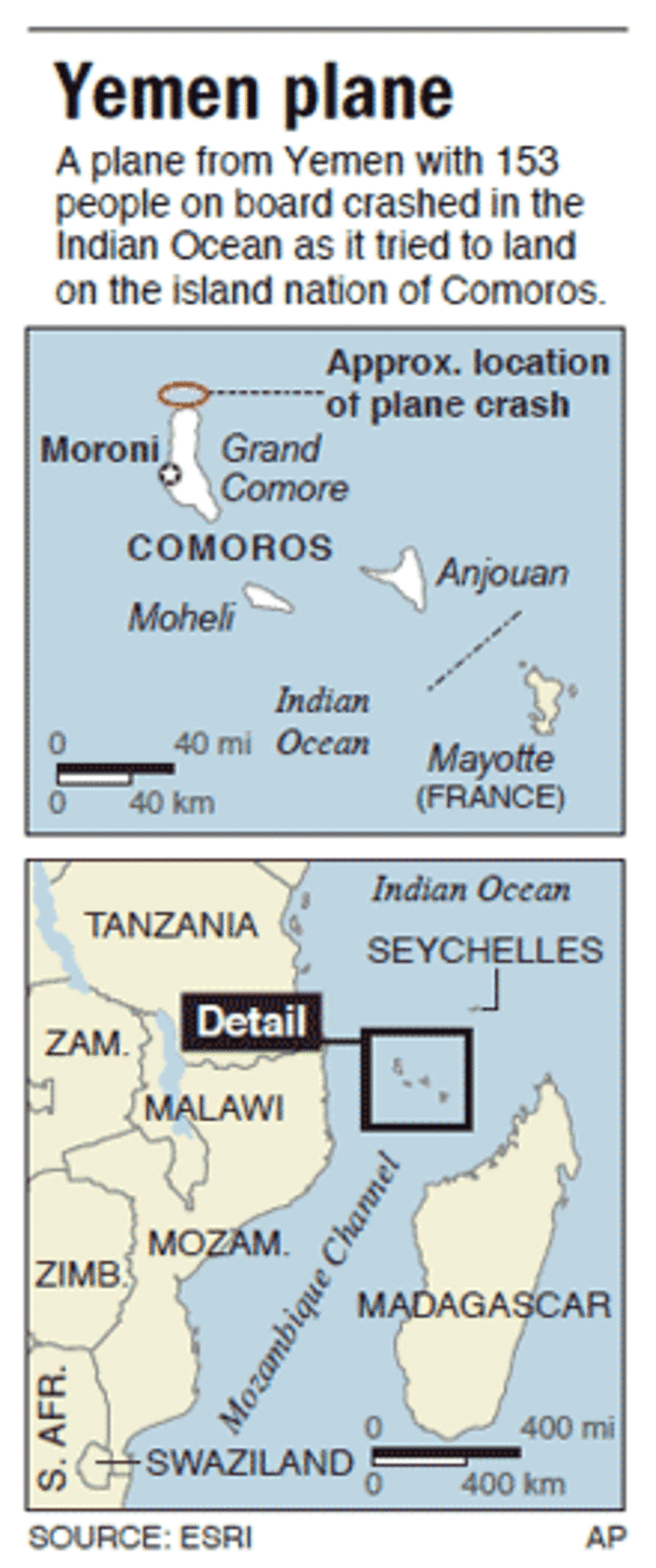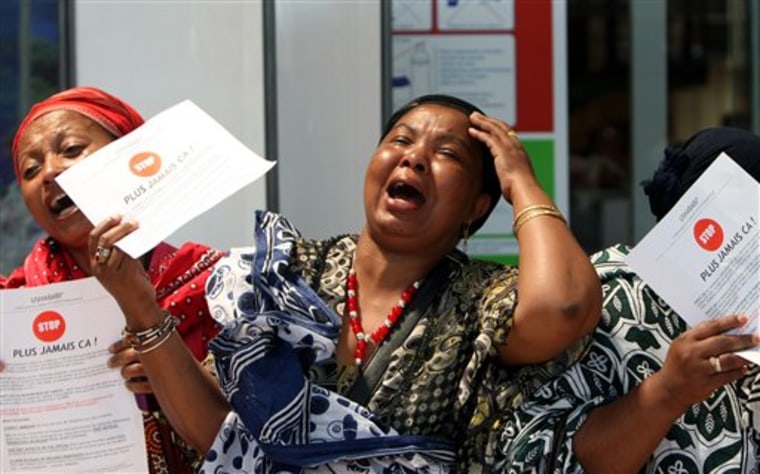First there was smoke, then flames burst out of the aircraft engine. But I was having difficulty communicating with the Mozambican flight attendant who was fussing with warm sodas and soggy sandwiches and did not speak English.
I got up, pulled on her arm and pointed at the fire.
It's been 30 years — and many more brushes with disaster in the air over Africa and other third world spots where poverty, war, extreme weather and corruption continue to plague airline safety.
It's a problem that grabbed the world's attention when a Yemenia airlines jetliner crashed into the Indian Ocean this week off the island nation of Comoros. Only one survivor, a 12-year-old girl, has been found; 152 others are feared dead.
Yemenia rejected criticism from French officials that the plane had a history of faulty equipment. The tragedy nonetheless brought to light long-standing complaints about flights that lacked seat belts and were so overcrowded that some passengers stood in the aisles.
It was on just such an overcrowded Libyan Arab Airlines flight from Tripoli to Benghazi in 1982 that a fellow passenger had another use for the aisle: He set down a paraffin-fueled camp stove and lit it to make some tea. There was pandemonium and a fistfight before the stove was switched off.
Many in Africa consider planes just another form of transport to cram with passengers and baggage, much like buses and ferries.
Still, flying probably is the safest way to get around the continent, and often the only way. Congo, which has experienced more fatal crashes than any other African country since 1945, is a vast country of jungles and huge rivers with little more than 300 miles of paved road.
In other countries, roads are so potholed from lack of maintenance that it can take days to cover a few hundred miles.
Airline deregulation, which came belatedly to Africa in the 1990s, brought new dangers. A plethora of airlines sprung up, frequently flying old leased Soviet-built aircraft with crews who spoke little English, the international language of aviation.
Still, there has been significant improvement since the African Civil Aviation Authority was set up two years ago, said Capt. Harry Eggerschwiler, its chief of operations.
"This is especially true of airlines flying on international routes. They have totally international standards of maintenance and safety," he told The Associated Press. "Internally there are still some problems, but we are progressing and pushing those operators very hard."
Most of the notorious fly-by-night outfits have shut down, Eggerschwiler said. He noted that of the 17 airlines from Angola on the European Union's list of banned carriers, only one was actually in operation.
In Nigeria, the pilot for one of those outfits found a novel way to handle an oversold flight from Lagos to northern Kano city that I was on in May 1992.
As I pressed against the glass door of the departure lounge with other irate passengers — our sheer weight threatening to crash through it — the pilot instructed us to run around the plane once and then board.
He then stood at the foot of the aircraft stairs with guards to prevent the overload from getting onto the plane.
I was as badly behaved as anyone, swinging my hefty hand luggage to make a path to the stairs. Riots had killed hundreds up north, and I had to get on that plane.
Africa's many wars have posed other dangers for flying. During Zimbabwe's 1972-1979 guerrilla war for majority rule, I flew on several small chartered planes that only on landing were found to be punctured with bullet holes.
These small aircraft did not have jet engines, like the ones that attracted the Soviet-made SAM-7 surface-to-air missiles that guerrillas used to bring down two Air Rhodesia jets in 1978 and 1979.
I should have been on one of those. It was Feb. 12, 1979, and I had spent a long weekend with friends at Lake Kariba, a popular tourist spot. The airport was mobbed with people trying to fly back to the Rhodesian capital, Salisbury, and an extra plane was brought in to handle the overload. I swapped my boarding pass for the first flight out.
It was only after I arrived home that I learned the other plane had been hit by a guerrilla missile. There were no survivors among the 59 people on board.
That said, today Air Zimbabwe is among a handful of African airlines that have gone fatality-free for at least the past 25 years, despite the political and economic crisis that has left the country's infrastructure crumbling. Others are Air Seychelles, Air Mauritius, Air Tanzania and Tunis Air.

When Monrovia was besieged during Liberia's civil war in the 1990s, an airline that rented Soviet-made Antonov cargo planes sprung up and was the only one flying out of the city after rocket and mortar attacks on its airfield in November 1992.
I was on one flight, crammed in so tightly in the cargo plane's canvas seats that we couldn't use the seat belts. Baggage was piled so high in the middle of the plane I couldn't see passengers on the other side. Suddenly, mortar and gunfire erupted.
Without warning, the pilot began taxiing. Passengers stranded on the tarmac ran screaming down the runway, hefting bags and babies. Several managed to jump onto the open tailgate and scramble aboard before the plane took off, cargo door still ajar.
Being a journalist in Africa doesn't always mean flying on risky planes. One luxurious flight I had in April 1994 was aboard the Ivory Coast's presidential jet, among journalists invited to interview now-deceased Angolan guerrilla leader Jonas Savimbi.
We were flown from Abidjan to Kinshasa, where we were met on the tarmac by a van that whisked us through a back gate with no immigration formalities.
We spent two days in a hotel, ordered not to go out since we were effectively in Zaire illegally. When a van took us back to the airport, we found a decrepit Soviet cargo plane waiting on the tarmac. I sat squeezed in beside 44-gallon drums of fuel for the flight to an unknown destination behind rebel lines in Angola.
That's a flight I should have said no to.
Still, dangerous and overloaded flights are not particular to Africa.
While in Haiti covering a presidential inauguration in February 1996, I needed to fly to the Dominican Republic to cover a plane crash that had killed all on board, mostly European tourists.
I booked a charter with a French company but when I saw the plane — a 1950s-era aircraft with peeling paint — I told the photographer that no one would blame us if we refused to fly.
The French pilot assured us his craft was better maintained than many with shiny coats of paint at the airfield in Port-au-Prince. And, he asked, why would he, a young man with a wife and two children, risk his life flying an unsafe plane?
I was persuaded, though we had some panicky moments when the plane barely scraped over the highest mountain in the Caribbean, Pico Duarte.
Three days later, the same plane and its French pilot crashed on takeoff from Port-au-Prince. Everyone died. Officials said later it was overloaded.
Associated Press Writer Slobodan Lekic in Brussels contributed to this report.
